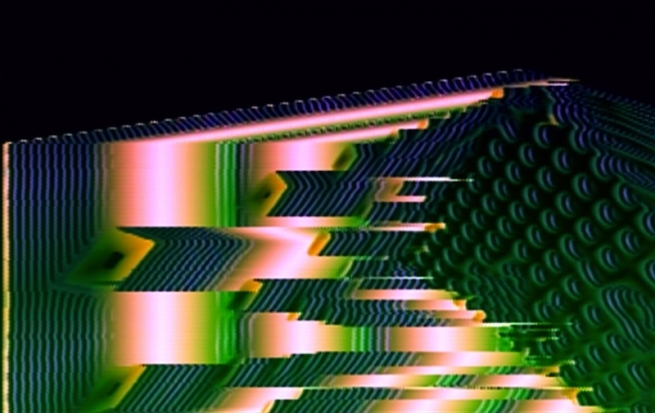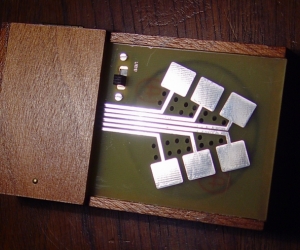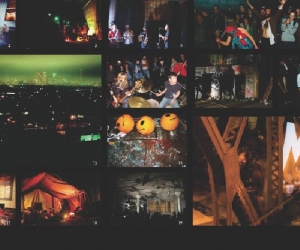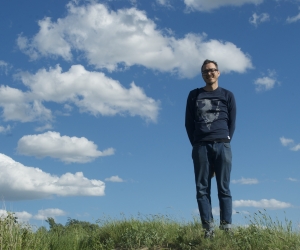
THE OCEAN RECEDES INTO THE DISTANCE, awash in thick bands of golden-purple sunset hues. Its surface ripples in loose synchronization with a burbling synthesizer score. Suddenly, a shimmering plane materializes and obliquely bisects the scene; the plane spins and the textures of the two surfaces soak into one another. The projection of these abstract seascapes radiates colour and—thanks to the myriad tiny reflective disco balls suspended from the ceiling—paints every surface in The Underground, the popular subterranean venue in Toronto’s Drake Hotel. To the left of the stage, two figures are poised at their laptops: Sabrina Ratté is alert, with her eyes locked on the screen, and Roger Tellier-Craig, immersed in the melody, engages in a gentle body rock.
Ratté and Tellier-Craig have individual practices, but in tandem they are Le Révélateur. They’re performing in Toronto as part of “Collapsible Landscapes,” a miniretrospective of their work, presented by the experimental media platform Pleasure Dome. Tasking visual artists with concert-production design is hardly novel, but this is much more than a slapdash tour-length collaboration: the duo have been working together for half a decade. With a moniker derived from Philippe Garrel’s 1968 experimental silent film, Le Révélateur fuses ornate synth-driven electronic music with a retro video aesthetic.
Tellier-Craig did stints as a guitarist in Montreal’s amorphous experimental ensemble Godspeed You! Black Emperor, as well as in Fly Pan Am and Pas Chic Chic, changing gears to focus on a solo electronic-music project in 2008. “I got a bit tired of working with other folks in a group context, so it just seemed like the logical thing to do,” explains Tellier-Craig, who cites Silver Apples, Cluster, Xenakis, Luc Ferrari, and Morton Subotnick as influences in his late teens, and, later on, Oval, Fennesz, and early Mego. Springing from a deep reverence for five decades of electronic music, Le Révélateur is all about “jumping in and exploring the world that had fascinated me for so long,” he adds. Tellier-Craig’s metaphor of terrestrial exploration does not do justice to his 2010 debut Motion Flares, whose pristine compositions feel larger by orders of magnitude: more musica universalis than terra nova.
In 2010, Tellier-Craig invited Ratté to develop with him a visual language to augment his kosmische-musik soundscapes. Ratté was honing an aesthetic driven by a fascination with early computer and video art and a workflow informed by her frustration with the protracted render-times associated with digital editing. “I was looking for a way to have a more spontaneous relationship with my medium,” she recalls. This desire for a more hands-on approach led Ratté to look beyond contemporary software and focus on video synthesizers and mixers, as well as live video feedback.
The first Le Révélateur video, Mirages (2010), opens to a listless melody and kaleidoscopic light-form floating atop a forest clearing. As the rhythm accelerates, the colour-soaked foliage is supplanted by a tilted grid and the haunting looped silhouette of a woman running in slow motion. In Afterimage Selves (2014), fields of feedback mimic crystal growth and oscillate along with shrill tones. Always in flux, they take aspatiality as a motif: rooms, landscapes, and more metaphysical continuums are constantly forming, but never quite congeal. Acting as Le Révélateur’s creative director, Ratté ensures that this viscous aesthetic is realized across the duo’s videos, album artwork, and promotional photos.
While the oceans of video feedback and the swelling melodies that Le Révélateur orchestrate at Pleasure Dome feel to be in keeping with their videos, the duo carefully avoids doing in performance what they've done on their recordings from Root Strata, Gneiss Things, and NNA Tapes. “The music I make is very layered and generated by hardware modular and semi-modular synthesizers, sometimes digitally processed through granular synthesis and sampled,” Tellier-Craig summarizes. “It’s very studio-based and hard to reproduce live, so I prefer simply having a bank of those samples, and triggering them along to Sabrina's videos.” Ratté displays similar fluidity and uses a MIDI controller and VJ software to mix her archive of carefully composed footage. Her trajectory from software to vintage analogue signal processing and back again perfectly sums up Le Révélateur’s retro-contemporary appeal. “The aesthetic can recall another era, because of the nature of the tools I use,” Ratté points out. “But I aim to transcend those references and become timeless.”


